Back Bouncing For Salmon: Pro Tips For More Fish
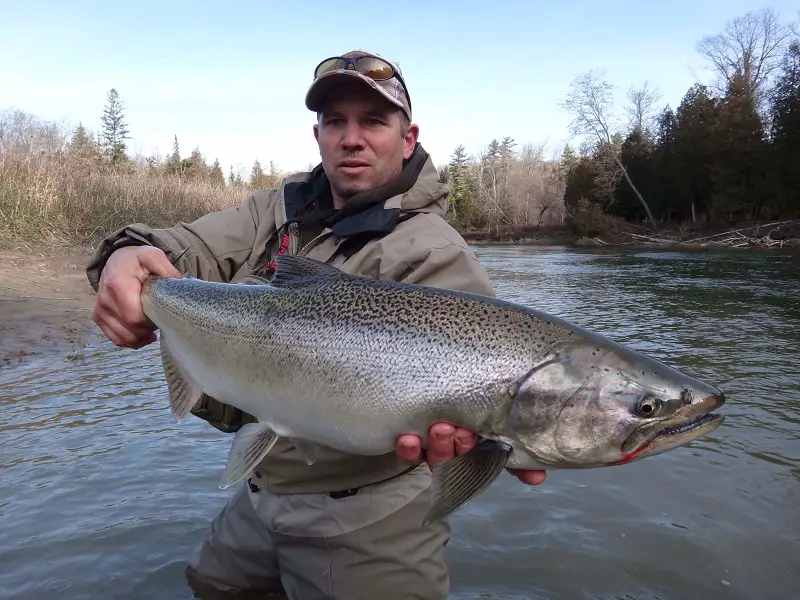
I have done a lot of back-bouncing for salmon over the last 30 years and do it in certain water types when I’m guiding. It works well for Coho salmon fishing, and King salmon fishing, but chum salmon and pinks can also be caught with this method.
If you are using these back-bouncing tips and tactics and the same back-bouncing rigs that the guides use, you will catch a lot more salmon. I’ll cover everything you need to know.
What is Back Bouncing For Salmon?
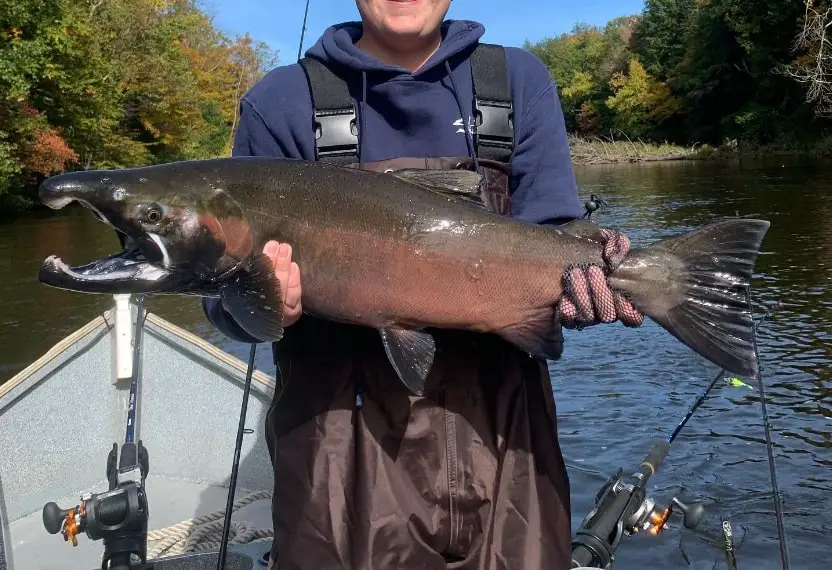
Back bouncing is a simple river fishing method used for salmon in faster water and deeper water. It involves dropping a large weight and a bait or lure to the bottom of the river where the presentation sits and dangles in the current flow.
You then quickly lift and slowly drop the weight every 5 to 20 seconds to slowly bounce the bait downstream.
Back bouncing for steelhead is also very effective.
How To Do The Traditional Back-Bouncing Method
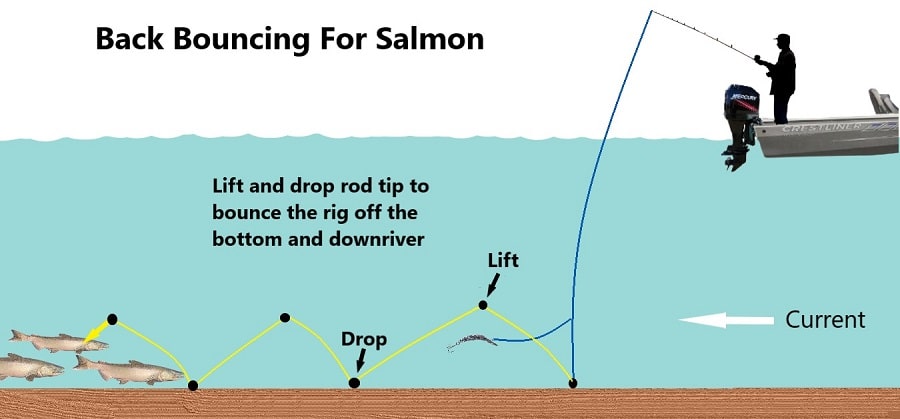
With the right amount of weight and a proven effective rig, you simply drop the weight off the back of the boat or cast it into the area you want to fish. You wait for the weight to hit the bottom, you’ll feel a thud when it hits. If using a bait, it will start leaving a scent trail.
Keep your rod tip at about eye level. After 5 to 10 seconds, lift the rod tip 4 to 5 feet, and at the top of the lift, let it free spool. This will lift your rig and let the current pull more line out while pushing your rig a bit and dropping the weight a foot or two downstream.
Repeat this method until your line is far enough downriver while still being able to feel the thump when the weight hits bottom. Too far down, and you might lose feeling and miss bites.
Some anglers say only go as far down so your line does not exceed a 45-degree angle. I will go further as long as I feel that I can still detect the weight and bites.
Repeat this method in different lines to cover the water, which I’ll discuss below.
Back Bouncing From A Boat
The most common way of salmon fishing while back bouncing is from a boat, and this is where it excels.
Stationary Boat: Often, the boat is anchored upriver from where the salmon are holding. An anchored boat lets you work the bait downriver with the rod tip and free spool to let line out.
Moving Boat: Some anglers will modify the method and both lift the rod to bounce the bait and they will also lift the anchor and let the boat move down 5 to 10 feet at a time to cover more water further down the river.
Back bouncing From Shore or While Wading
Some anglers will successfully back bounce for salmon from the bank or while wading out as far as possible. In some cases, this is similar to drift fishing, except you use more weight so the bait is drifting the whole time.
Wading Out – Wading out and getting as directly upriver from the salmon is a good way to drop the weight down and into the holding salmon. Just be sure it’s safe to wade out.
From The Bank – Back bouncing for salmon can also be done from the bank in areas where your rod tip can get up and across from the holding salmon.
Back Bouncing For Salmon With Bait
Many anglers will back bounce with bait downstream. Good salmon baits leave a scent trail that the salmon will pick up on long before they see the bait. Once the bait releases scent and then gets within sight, they likely grab it.
Common baits are skien, cured eggs, spawn sacks, shrimp, and cut hearing. Most of these baits release scent, especially if they are cured.
Lil’ Corky And Spin-N-Glo Back Bouncing
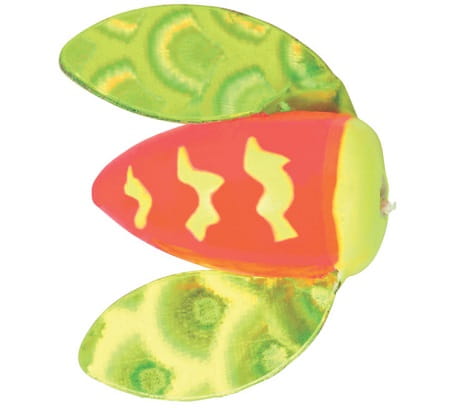
Adding a Lil’ Cory or a Spin-N-Glo off the leader with a trailing bait can add height to the bait, keep it off the bottom, and attract more salmon to the bait.
Back Bouncing For Salmon With Lures
Bottom bouncing can be done with lures like spoons, spinners, crankbaits, and plugs.
Back bouncing with plugs is the most common lure used for back bouncing , and good plugs include Kwikfish T13 and T14, Flatfish M2, and T50 to T60, and Yakima Maglips from 4″ to 5 inch.
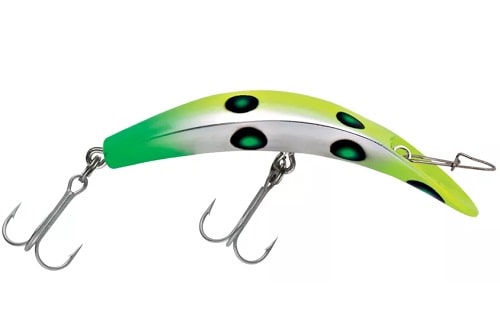
Back bouncing with plugs can be done in two ways. The first way is the traditional method in typical fast water with a weight that securely holds the lure in place until the rod tip is lifted and dropped
The second method involves less weight and a large plug that slowly drags the weight down the river with period lifts. See below for more.
Guide Tip: Smaller lure sizes for lower water, bigger lures for higher water. Larger lures tend to go deeper.
I discuss other great salmon lures and the best colors on my page Best Salmon Lures.
The Go Big Technique For Slower Deeper Water
When plug fishing for king salmon in slower deeper water, traditional back bounce doesn’t work so well, so a modified method is the Go-Big technique, which uses a lighter weight and a bigger plug such as the Worden’s Flatfish – T55 and T60. You want just enough weight to get the weight and plug to the bottom but not so much that it anchors the plug in place.
The plug basically drags the weight at a slow speed down the river.
Drop the weight and plug with light thumb pressure to let the large plug pull the weight along the bottom for about 10 feet. Stop the plug by stopping the line coming out and wait for the rod tip to start pulsating. After 10 seconds, let the line slip out another 10 feet and stop. Repeat until you are at the end of the drift or the current is too slow to pull out the line.
You may need to experiment with the weight, which can be a half-ounce to 3/4 ounce.
How Much Weight Should You Use?
The amount of weight you use for back bouncing will depend on the depth and velocity of the spot you are fishing. You want just the right amount of weight that it will thump when the weight hits the bottom, and it will hold without being carried downstream on its own.
You also want just enough weight that when you lift the weight off the bottom the current flow can still push the weight 6 inches to 24 inches down the river.
In fast currents with water that is 8 feet deep or more, a 2-ounce ball weight is ideal. In slower water, a one-ounce to 1.5-ounce ball weight is good.
The Hovering Method
The hovering method is a variation using the same rig. You do this directly over the fish by letting the bait drop hitting the bottom and then lifting it up off the bottom 3 to 5 feet and waiting for the salmon to hit it.
Some anglers will use oars or a trolling more to slowly and quietly let the boat drift downriver.
What Type Of Water Is Good For Back Bouncing?
Back bouncing is best on medium to larger rivers with deep holes, drop-offs, ledges, and deep water below faster water. You want a current speed of a fast walking speed or more.
The depth can be as shallow as 6 feet however, 9 to 20 feet is best.
Covering Water When Back Bouncing
Whether you are in an anchored boat above the salmon or you are wading or fishing from shore. It is best to spread your bait out in 2 to 3-foot lines each time you drift.
I start on one side of the boat with my line as far out the side as possible and work my way across to the other side of the boat.
If it’s a wide river, I will also start the boat, lift the anchor, shift the boat over 20 feet, anchor, and repeat.
When one spot is fully covered, move to the next spot and repeat.
Detecting A Bite And Setting The Hook
When fish with plugs and lures, the bite is usually agressive. Set the hook when the line starts peeling out.
When fishing with bait, the bite can be more subtle, sometimes you’ll just start to see the rod tip pulsating.
Most anglers believe that the salmon are mouth or picking at the bait and will wait until the salmon grabs it, turns, and runs. They say, wait, wait, wait, and set.
I personally prefer to set almost immediately, proving that there is steading movement on the rod tip. If the rod tip is moving steadily the fish has it in its mouth, so set the damn hook.
However, if the rod pops or jumps and goes limp, this is a salmon mouthing or playing with the bait, in which case, wait until it commits and pulls line.
Back Bouncing Equipment
Rods – You should use any rod between 7.5 to 9 feet, any longer, and you’ll have trouble feeling the bait and bites. Use a medium-heavy action rod so it’s stiff yet responsive and sensitive enough to feel a bite. Remember, your rod needs to be able to handle large king salmon. See Best Rods For Salmon.
Reels – Many anglers like low profile bait casters for this method so they can feather the line off the reel with each lift. However, you can also use a spinning reel for this method. A good reel with suitable line capacity and a smooth drag for long runs is a must. A 3500 to 4000 spinning reel is best. See Best Reels For Salmon.
Line – For the line, a 30 to 50-pound braided line by Sufix, Tough Line, or PowerPro and a 3 to 5-foot leader of 20 to 25-pound fluorocarbon will work for big king salmon. I’ll drop to 14 or 16 pounds for coho and steelhead. See Best Line for Salmon.
Guide Tip: Since the salmon don’t seem to be line shy, some guides will use up to a 30-pound leader which is heavy enough to straighten out the hooks if you get snagged so you get your lure back.
Terminal Gear
- Swivels
- Hooks – 2 aught to size 6, I adjust my hook size to the bait
- Lead ball weights – Ball weights don’t get suck in rocks as easily.
- 6mm Bead – goes above the swivel as a stopper
- Leader – two sizes is best, 14 to 20 pound for the leader to the bait or lure, and a leader that is 2 to 4 pounds lighter for the dropper with the weight. This lighter dropper leader ensures that only the weight breaks off if you get snagged.
Back Bouncing Rig For Lures
The key to this rig is to use a sliding swivel.
I will also use a large open loop knot so I can switch out weight sized without retying.
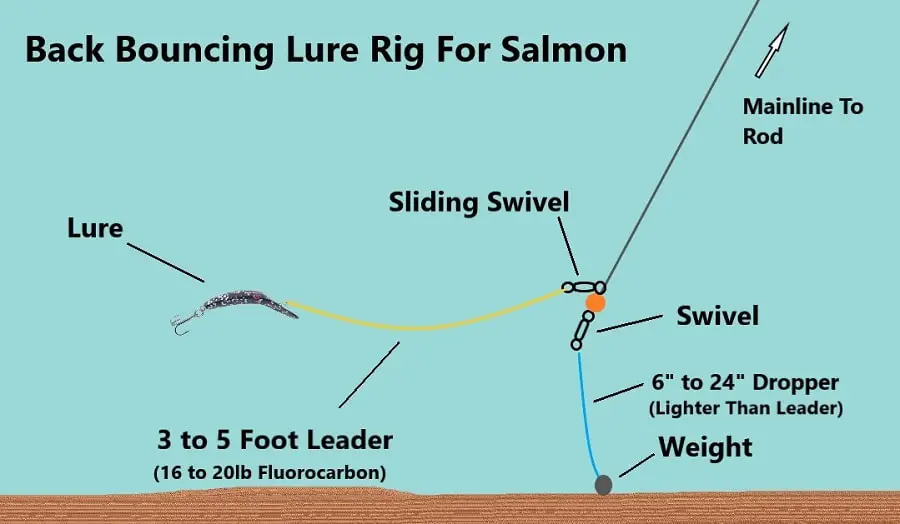
Back Bouning Rig For Bait
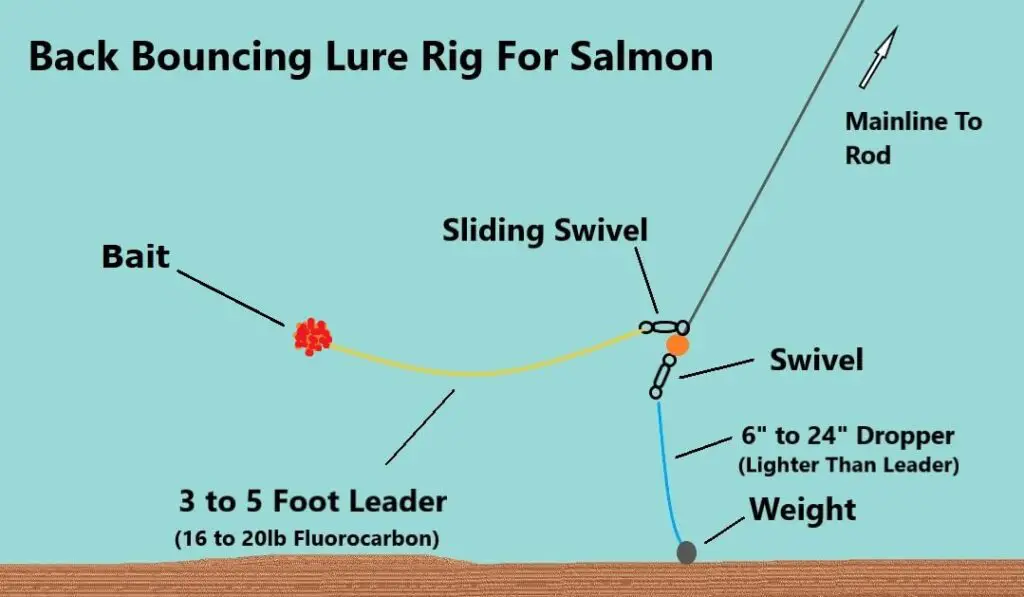
Back Bouncing For Salmon Q&A
If you have a question or comment about back bouncing for salmon, let us know in the comments below.
Tight Lines
Graham
